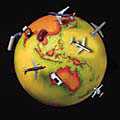 About F&D Subscribe Back Issues Write Us Copyright Information Free Email Notification Receive emails when we post new
items of interest to you. |
Picture This The Truth About Industrial Country Tariffs Average tariff rates mask one important fact: the poor get hit the hardest What's wrong with tariff structures? Although most tariffs in industrial countries are low, those on several categories of goods remain prohibitively high. Tariffs on many consumer, agricultural, and labor-intensive products are 10-20 times higher than the overall average tariff. For example, U.S. import tariffs on clothes and shoes average 11 percent and go as high as 48 percent. Although, in 2001, clothes and shoes accounted for only 6.5 percent of U.S. imports, in value terms, they brought in nearly half of the $20 billion of U.S. tariff revenue (Table 1). Other industrial economies are no different. The European Union (EU), for example, applies tariffs of up to 236 percent on meat, 180 percent on cereals, and 17 percent on sneakers. In contrast, its tariffs on raw materials and electronics rarely exceed 5 percent.
Who gets hurt? Developing countries that export primarily agricultural and labor-intensive goods such as textiles and clothing are hard hit by industrial countries' tariff policies. One can clearly see the disparate effects of these tariffs by looking at the effective tariff rates—the amount of import duties collected as a percent of total imports—of different countries. For example, on imports of $2.5 billion from Bangladesh (a major clothing exporter), the United States collected duties of $331 million in 2001—slightly more than the $330 million it collected on $30 billion of imports from France (Table 2). Thus, poor countries like Bangladesh—that are beginning to move from subsistence agriculture and dependency on exports of primary commodities into light manufacturing—face the highest effective tariffs, on average, four or five times those faced by the richest economies.
Who else gets hurt? Tariffs that single out clothes and shoes also harm consumers in industrial countries. These tariffs weigh heavily on lower-income groups, which spend a large share of their income on such basic necessities (Table 3). A single-parent family in the United States, for instance, has an average income of $25,095 a year and spends $1,851 on clothes and shoes. Import duties are estimated to account for as much as $307 of that amount—equivalent to1.2 percent of household income. But the average income of a two-parent family is $66,913, and the amount it pays on import duties is $470 or 0.7 percent of its income—a much lower proportion than single-parent families. To make matters worse, tariffs applied to similar categories of consumer goods are often higher on the cheaper goods than on the luxury versions. The U.S. tariff on imported silk shirts is only 1.9 percent, while it is 20 percent on cotton shirts, and 32.5 percent on synthetic-fiber shirts (Table 4). Thus, the tariff structure on these products is a regressive tax on the poor, who can least afford to pay.
Tariff structures of this sort are not limited to textiles. Another type of discriminatory tariff is tariff escalation—when tariffs increase with the degree of processing involved in the product. Cocoa beans are taxed at a lower rate than cocoa butter, which is taxed at a lower rate than chocolate. Tariff escalation is also seen in many major developing countries (see chart).
Prepared by Dustin Smith, Senior Research Officer in the IMF's Policy Development and Review Department. Based on Edward Gresser, 2002, "America's Hidden Tax on the Poor: The Case for Reforming U.S. Tariff Policy," Progressive Policy Institute Policy Report (Washington). See http://www.ppionline.org/documents/Tariffs_Tax_the_Poor.pdf |
||||||||||||||||||||||||||||||||||||||||||||||||||||||||||||||||||||||||||||||||||||||||||||||||||||||||